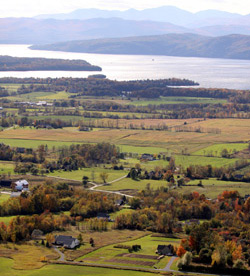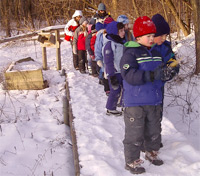Learning in the Lake Champlain Basin

If you have been within sight of the Lake and its drainage basin, you can easily grasp the significance it has held for residents for thousands of years. It is a source of sustenance, transportation, trade, and recreation. With all these touchstones, the area is an exciting place to explore with learners of any age.
The Lake Champlain Basin is rich with many stories that can be explored and woven from and to traditional school subjects, school community partnerships, and meaningful service. Teachers have many different kinds of learning opportunities to share with students.
Learning to learn outside the classroom challenges the teacher in new ways. As one teacher reflected, it is “more than just a walk in the woods.”
 While exploring local watersheds, teachers learn to teach differently. They learn to partner with the local environment; the rivers, streams, and shorelines provide their own lessons that teachers learn to incorporate into their plans.
While exploring local watersheds, teachers learn to teach differently. They learn to partner with the local environment; the rivers, streams, and shorelines provide their own lessons that teachers learn to incorporate into their plans.
Place-based education encourages us to think of places (and people and things) as authentic “sites of engagement”—places where students come face to face with many of the live, perplexing, and surprising lessons the world has to offer!
Studying the Revolutionary War?
...Visit a life-sized replica of a Revolutionary gunboat.
Studying plate-tectonics?
...Visit the Champlain Thrust (view from ferry or—with landowner permission—visit the site) or view the Charlotte Whale at the Perkins Museum or Ausable Chasm.
Studying slavery?
...Visit John Brown’s home at the John Brown Farm State Historic Site.
Studying water quality?
...Visit a waste-water treatment plant near you.
Studying wildlife habitat?
...Adopt a salmon
Explore more places to learn in the Lake Champlain Basin here.

